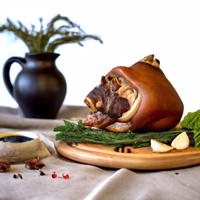
1 serving (100 grams) contains 206 calories, 23.0 grams of protein, 12.0 grams of fat, and 0.0 grams of carbohydrates.

Log this food in SnapCalorie

Nutrition Information
Calories |
490.5 | ||
|---|---|---|---|
% Daily Value* |
|||
| Total Fat | 28.6 g | 36% | |
| Saturated Fat | 10.7 g | 53% | |
| Polyunsaturated Fat | 0 g | ||
| Cholesterol | 190.5 mg | 63% | |
| Sodium | 154.8 mg | 6% | |
| Total Carbohydrates | 0 g | 0% | |
| Dietary Fiber | 0 g | 0% | |
| Sugars | 0 g | ||
| protein | 54.8 g | 109% | |
| Vitamin D | 0 mcg | 0% | |
| Calcium | 26.2 mg | 2% | |
| Iron | 5 mg | 27% | |
| Potassium | 785.7 mg | 16% | |
* Percent Daily Values are based on a 2,000 calorie diet. Your daily values may be higher or lower depending on your calorie needs.
Food Attributes
Source of Calories
About Leg roast
A leg roast is a flavorful cut of meat, typically sourced from lamb, pork, or beef, prized for its tenderness and rich taste. Commonly associated with European cuisines, it’s a popular centerpiece in traditional roasts or festive meals. This dish often features simple seasonings like garlic, rosemary, and olive oil, enhancing its natural flavors. Nutritionally, leg roast is a protein-rich food, supporting muscle repair and overall development. It also provides essential vitamins like B12, iron, and zinc. However, depending on the cut and preparation, it can be high in saturated fat, which should be consumed in moderation. Roasting it with vegetables, opting for leaner cuts, and trimming excess fat can make it a healthier choice. Perfect as a satisfying, nutrient-dense addition to your meal, leg roast combines tradition and taste in every bite.



